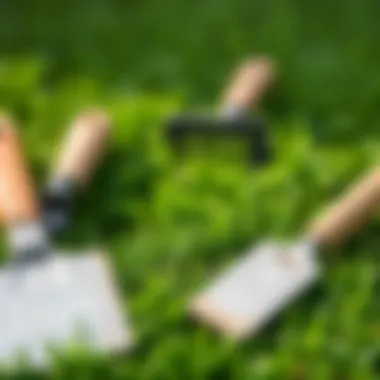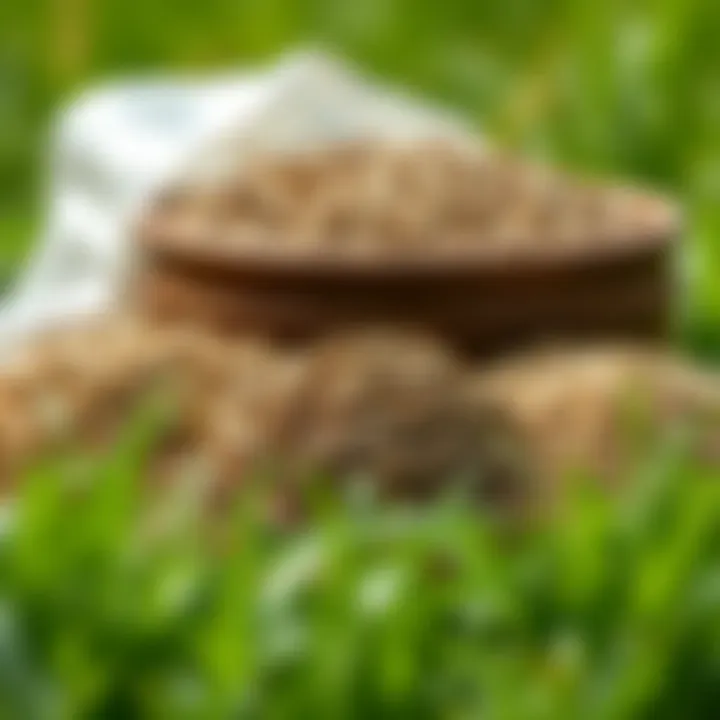Mastering the Art of Overseeding Your Lawn This Spring


Intro
Overseeding a lawn in spring is akin to nurturing a blank canvas into a vibrant masterpiece. It involves a careful process equipped with a sound understanding of the flora, soil, and seasonal patterns. As homeowners and gardening enthusiasts, recognizing the significance of this seasonal task can provide substantial rewards, including a lush, thick carpet of greenery that enhances the aesthetic appeal of any property. By revitalizing thin or bare areas, overseeding can turn a lackluster lawn into a vibrant landscape.
Successful overseeding hinges on several key factors: preparation, the right type of seed, timely execution, and ongoing maintenance. These elements work harmoniously to create an inviting outdoor space that not only fosters outdoor enjoyment but also supports local ecosystems. So, whether your goal is to create a play area for children, a serene spot for relaxation, or simply to increase your home’s curb appeal, getting the overseeding process right can set you on the path to success.
In this guide, we will explore:
- The essential preparatory steps for overseeding
- Different types of seeds suited for various climates and preferences
- Strategies for executing the overseeding process effectively
- Maintenance tips and schedules to keep your lawn healthy post-overseeding
With a thorough understanding of these steps, you can embrace the spring season and give your lawn the best shot at thriving.
Gardening is as much about technique as it is about passion. By equipping yourself with the right knowledge and insights, you will not only improve your lawn but also experience the satisfaction of witnessing your hard work pay off. Let’s dive deeper into how to make this spring your lawn's best yet.
Preface to Lawn Overseeding
Lawn overseeding is an essential practice that allows homeowners to revitalize and maintain the health of their lawns, especially during the spring. As the cold fades and temperatures rise, the grass begins to awaken from its winter slumber. Here, overseeding plays a crucial role in enhancing the plight of any tired yard, and it’s about time to give your lawn a much-needed boost.
Understanding Overseeding
Overseeding is the process of sowing grass seed onto an existing lawn without tearing up the turf. It’s akin to giving your lawn an upgrade, helping it to recover from the wear and tear it experienced over the previous year. This technique not only introduces new varieties of grass but can also improve the overall density and health of your lawn. When done correctly, overseeding can close up patches, thicken your grass, and even enhance color, creating a lush, green carpet that beckons for bare feet.
Moreover, overseeding can make your lawn more resilient against pests and diseases. By diversifying the grass types in your yard, you can increase its resistance to various stressors like drought and harsh weather. Thus, understanding overseeding is not merely a matter of lawn aesthetics, but also a crucial aspect of sustaining a vibrant outdoor space.
Benefits of Spring Overseeding
Spring is by far the best time for overseeding which boasts several benefits:
- Improved Germination Rates: In spring, soil temperatures rise, creating the perfect environment for seeds to germinate; the ground is warmer and moisture levels are optimal.
- Optimal Growth Conditions: The longer days and abundant sunlight during spring months foster ideal growth conditions. Grass that germinates now will have a better chance of establishing strong roots before the summer heat kicks in.
- Weed Suppression: By overseeding in the spring, you can outcompete weeds for resources. With a thicker lawn, there’s less room for weeds to take root, thereby reducing your lawn maintenance efforts later.
- Enhanced Lawn Appearance: Nothing beats a vibrant and uniform lawn. Spring overseeding can help fill in those pesky bare patches and give your yard a fresh, lush look that stands out.
"A well-maintained lawn can improve both curb appeal and property value."
In summary, overseeding is not just a practice for the landscape enthusiasts; it is a necessary step for any homeowner seeking to improve their outdoor space. By understanding overseeding and its kinetic benefits when timed with the spring season, you set up a foundation for a thriving lawn that beckons both admiration and foot traffic.
Preparing Your Lawn for Overseeding
Preparing your lawn for overseeding is like setting the stage for a grand performance; you can't expect a stunning show if the groundwork isn't solid. Before flinging seed everywhere, you need to survey the area. Each inch of your lawn holds potential but also historical baggage. Assess what you're working with, clean up the clutter, and time it just right to plant those seeds. The effort you put into these preparatory steps can make all the difference between a vibrant lawn and a patchy mess come summer.
Assessing Your Lawn's Condition
Every lawn has its personality, and knowing yours is essential. Start by taking a good, long look. Are there bare spots or areas that seem to have more weeds than grass? The condition of your lawn will dictate how you need to approach overseeding. Use the following checklist to assess:
- Soil Quality: Is it compacted or sandy? You may need to aerate if it’s tightly packed.
- Existing Grass Health: Take note of how healthy the current grass is. If it’s mostly brown, the solution might not just be overseeding but addressing underlying issues.
- Drainage: Observe how water settles in the area. Poor drainage could compoun your issues.
- Light Exposure: Does your lawn get full sun, partial shade, or is it in the dark? Different grass types have varying sunlight needs.
Recognizing these elements not only prepares you for what lies ahead but also instills confidence as you work on giving your lawn the boost it needs.
Cleaning the Lawn


After assessing, it's time to clean. Think of this like decluttering a room; you can't invite guests (or in this case, seeds) over with junk lying around. Here's how to tidy up:
- Remove Debris: Clear out leaves, twigs, and any clutter. If you can’t see the grass, the seeds won’t either.
- Mow: Give the grass a fresh cut, keeping the blades high. This encourages new growth without strangling underneath roots.
- Weed Control: Tackle those pesky weeds. Consider using a natural herbicide if you’re facing a real infestation, or simply pull them by hand if they aren't that many.
- Rake and Aerate: Raking helps loosen the soil surface, making it easier for seeds to make contact. Aerating, while optional, can be useful if you notice compacted soil.
By cleaning your lawn, you're essentially creating a blank canvas, ensuring that the seeds you plant have the best possible chance to flourish.
Choosing the Right Time
Timing is everything in gardening. Planting at the wrong time can lead to disappointing results. Spring is generally regarded as the golden season for overseeding, but there are nuances worth considering. Woefully low temperatures can hinder seed growth. Ideal soil temperatures range from 50 to 65 degrees Fahrenheit, making early spring often the sweet spot between chilly winter and scorching summer.
Tip: Keep an eye on the weather. A sudden drop in temperature or unexpected frost can ruin your plans. It’s best to wait until the danger of frost has passed.
Also, pay attention to rain cycles. If you're in a wet region, overly saturated soil could drown those delicate new seeds. On the flip side, in dry areas, you need good moisture levels to encourage proper germination.
In summary, preparing your lawn is not just about making it look nice — it's about optimizing conditions for growth, ensuring that your efforts in overseeding yield a healthy, green carpet come summer.
Selecting the Appropriate Seed Type
Choosing the right seed for your lawn is crucial when overseeding in spring. This process not only enhances the appearance of your lawn but ensures sustainability and health in the long term. With a variety of grass types available, understanding how to match the right seed variety with your lawn’s unique conditions can make a world of difference.
Evaluating Grass Varieties
Grass varieties come in numerous flavors, each with its own set of characteristics tailored to specific environments. Before selecting a type, here are some key factors to consider:
- Growth Habit: Understanding if the grass grows in clumps or spreads horizontally can affect lawn density. For instance, Kentucky bluegrass tends to create an expansive cover, while Bermuda grass grows more aggressively, making it ideal for high-traffic areas.
- Color and Texture: Aesthetics matter; different varieties have distinct colors and textures. Fescue varieties provide a fine texture, giving lawns a soft touch, while zoysia grass combines a rich green hue with dense coverage, perfect for sunny spots.
- Sun and Shade Tolerance: Different grasses thrive under varying sun exposure. For shade, look for shade-tolerant varieties like fine fescue, whereas for open, sun-drenched lawns, the resilient Bermuda may be your best bet.
- Maintenance Needs: Some grasses require more upkeep than others. For example, tall fescue is hardy and drought-resistant, needing less water and mowing compared to cool-season varieties like ryegrass, which may require more frequent care.
Each variety has its pros and cons; therefore, evaluate them based on your specific lawn conditions and personal preferences.
Understanding Regional Considerations
Your geographical location plays a significant role in the success of your overseeded lawn. Climate considerations include:
- Cool vs. Warm Season Grasses: Areas with hot summers and mild winters are suitable for warm-season grasses such as Bermuda or zoysia. In contrast, northern regions suited to cooler climates are often better off with Kentucky bluegrass or perennial ryegrass.
- Soil Type: Different seeds adapt to specific soil types—loamy, sandy, or clay. If your soil remains compacted, it might be worthwhile to select a variety like tall fescue, which adapts better to poor soil conditions than other varieties.
- Precipitation Patterns: Regions with low rainfall need drought-resistant options. Consider seed varieties that are known for their water efficiency. For instance, buffalograss is a drought-tolerant type that performs well in arid climates.
- Local Regulations and Norms: An important aspect many overlook is checking local gardening regulations. Some specific types of grass are prohibited in certain areas due to environmental concerns, thus it’s crucial to inform yourself on permissible varieties.
"Selecting the appropriate seed type tailored to both your climate and expectations can make the difference between a patchy lawn and a lush, green oasis."
Taking the time to evaluate these elements can provide a solid foundation for a thriving lawn. While it might seem a bit daunting, this groundwork can save you from headaches down the line and contribute to the long-term health of your landscape.
The Overseeding Process
The overseeding process is a crucial stage in revamping your lawn, especially in the spring when conditions are ideal for grass growth. When carried out properly, overseeding can breathe new life into an otherwise tired looking landscape. With a little investment of time and effort, you can enhance the density of your turf, improve its resistance to disease, and create a vibrant space for both aesthetic pleasure and outdoor play. This section will detail the necessary steps to ensure that your overseeding efforts yield fruitful results.
Equipment Needed for Overseeding
Before you dive head first into overseeding, having the right tools is essential. The process can be quite challenging without the appropriate equipment. Here are some must-haves:
- Broadcast Spreader: This tool is designed to distribute your seed evenly across the lawn. Handheld options are great for smaller areas, while a push spreader is more efficient for larger yards.
- Aerator: By perforating your lawn, an aerator allows for better seed-to-soil contact and improves water absorption.
- Rake: After overseeding, a light raking helps cover the seed and is also good for breaking up soil clumps.
- Sprayer or Hose: For watering after seeding, consider either a nozzle that can deliver a fine mist or a dedicated sprayer.
Having these tools on hand can make the process smoother and more effective. If you’re unsure where to find them, local garden centers or rental stores often carry reliable models.


Applying the Seed Evenly
Once you have your equipment ready, the next step involves applying the seed evenly. It’s not just a matter of tossing seeds on the lawn. There’s a bit more finesse required here to ensure that the new grass has adequate space to grow. To do this:
- Choose the Right Seed Rate: Each grass variety requires a specific amount of seed per square foot. Check the seed package for the recommended guidelines. Generally, it can range from 5 to 10 pounds per 1,000 square feet.
- Use Your Spreader: Fill your broadcast spreader with the seed and set it to the correct setting per the manufacturer’s instructions. Walk at a consistent pace to avoid over-seeding or under-seeding.
- Cross Pattern: To achieve even distribution, make your first pass in one direction, then change it up by making a pass perpendicular to your first pass. This criss-cross method helps cover all areas uniformly.
- Lightly Rake: After distributing the seed, a gentle raking can cover the seed lightly, which is important to protect it from birds and provide better soil contact.
Applying the seed evenly is vital to the overall success of your overseeding endeavor. Uneven patches may lead to inconsistent growth, which could be frustrating in the long run.
Watering After Seeding
Watering is an especially critical part of the overseeding process. The newly planted seeds require a delicate balance of moisture without being drowned. Here’s how to get it right:
- Water Immediately: As soon as the seeds are sown, water the area gently. A soaker hose or fine mist from a spray nozzle can help prevent the soil from washing away.
- Keep it Moist: For the first two weeks, it’s essential to keep the top layer of soil consistently moist. Water lightly but frequently, aiming for about 1 inch of water every week.
- Gradual Reduction: Once you see seedlings emerging, gradually reduce the frequency of watering while increasing the duration to encourage deeper root growth.
Remember, over-watering can be just as detrimental as under-watering. Monitor the soil moisture and adjust according to the weather conditions.
With the right preparation and attention to detail, you can effectively overseed your lawn, setting the stage for a lush and healthy yard. Following these steps carefully can make a world of difference in the success of your lawn’s growth this spring.
Post-Overseeding Care
Taking care of your lawn after overseeding is just as crucial as the overseeding itself. This period sets the stage for the new grass to thrive. Ideally, it’s about combining patience with diligence. When the grass shoots up, it needs protection and nourishment, and understanding the ins and outs of post-overseeding care is vital for achieving those lush, green results.
Monitoring Seed Growth
As the seeds germinate, it’s paramount to keep a close eye on their growth. Expect to see little sprouts popping up two to three weeks after overseeding, depending on the seed type and environmental conditions. Regular monitoring gives you a chance to evaluate the effectiveness of your overseeding efforts.
- Check for Evenness: Look across your lawn to see if the new grass is growing evenly. If there are patches where grass seems sparse, it might need a little extra attention or reseeding.
- Soil Moisture: Keep an eye on the moisture level in the soil. Grass seeds thrive in damp conditions but they don't like to drown. A daily inspection of your lawn can help to verify if it's too dry or if the ground is saturated.
- Weed Growth: Sometimes, weeds can try to take advantage of the newly disturbed soil. Maintaining a vigilant eye for any unwanted greenery is key. Addressing weeds promptly allows the new grass to establish itself without competition.
Fertilizing Following Overseeding
Fertilization plays a significant role in post-overseeding care. It provides essential nutrients that help young grass establish strong roots. However, the type and amount of fertilizer should be approached with care.
- Wait for Seedlings: After seeding, hold off on fertilizing until you see the grass starting to grow. Applying too soon can burn delicate seedlings.
- Choose the Right Fertilizer: Opt for a starter fertilizer high in phosphorus, as it encourages root development. Something like a starter fertilizer labeled 12-24-12 can be beneficial. Avoid any high-nitrogen fertilizers until the grass is well established.
- Evently Spread It: Once you're ready to fertilize, make sure to spread it evenly across your lawn. Using a broadcast spreader can aid in achieving a balanced distribution, helping your grass grow uniformly.
Mowing Considerations
It’s essential to approach mowing with care when your newly overseeded grass is ready. Cutting it too early can cause unnecessary stress, while waiting too long might lead to an unkempt appearance. Keeping a few points in mind will help maintain a healthy lawn:
- Set the Right Height: Let the new grass grow to at least 3 to 4 inches before the first mow. This height ensures stronger root systems.
- Mow with Sharp Blades: Always use sharp blades for a clean cut. Dull blades can tear grass rather than cut it, increasing the risk of disease.
- Avoid Cutting Too Short: When you do mow, it’s best to follow the one-third rule. This means cutting no more than one-third of the blade height. Cutting too short stresses the grass and can hinder its growth during its crucial establishment phase.
As you engage in this nurturing phase of post-overseeding care, remember that every lawn is unique, and adjusting your practices to suit your specific situation will yield the best results.
"Your lawn is a living ecosystem, and it requires thoughtful care after overseeding to flourish."
By investing attention during these post-seeding weeks, you are allowing your grass the best chance to grow healthy and robust, ensuring the beauty of your landscape for months (and years) ahead.
Challenges During Overseeding


Overseeding your lawn in spring is an undertaking that often promises lush greenery and healthy growth. However, this journey isn’t always a walk in the park. Various challenges can crop up along the way, potentially jeopardizing your hard work. Understanding these challenges is crucial for any homeowner or gardening aficionado looking to maintain a vibrant lawn. Common issues can range from improper seed application to dealing with pests and diseases that might disrupt the growth of your newly sown seeds.
Addressing these difficulties in advance sets the groundwork for success. By learning to navigate through potential pitfalls, you can transform obstacles into opportunities for improvement. This section will delve into the most prevalent challenges encountered during overseeding and equip you with effective solutions for each.
Common Problems and Solutions
When overseeding, there are several common issues that can arise, each demanding unique solutions. Here are some of them:
- Poor Seed Germination: Seeds may fail to sprout due to various factors like unsuitable weather conditions or improper soil preparation. To tackle this, ensure the soil is well-aerated and moist, which creates an ideal environment for the seeds. Also, pay attention to projections about upcoming temperature fluctuations.
- Soil Compaction: Compacted soil can block water and air from penetrating, making it harder for seeds to germinate. Regularly aerate the lawn, especially before overseeding, to break up soil compaction. You can use a core aerator, which removes plugs of soil and promotes a healthier root system.
- Uneven Seed Distribution: Spreading seeds unevenly can leave patches of bare areas. Using a broadcast spreader can help in evenly distributing the seeds across the lawn. If you notice that some areas have significantly more seeds than others, consider a light raking to redistribute them.
- Competition from Existing Grass: Existing grass may compete for resources with the new seeds. To combat this, mow the existing grass lower before overseeding, but be careful not to scalp it. This allows sunlight to reach the new seeds better, reducing competition.
- Weeds: Weeds tend to be the unwelcome guests in any overseeding process. A pre-emergent herbicide can help control weed growth, but be wary of its usage right before overseeding, as it can inhibit your new seeds. Timing is key here; applying it after those new seeds have germinated ensures a more successful outcome.
"Being mindful of common problems can save time, effort, and resources, paving the way for a flourishing lawn."
Identifying Pests and Diseases
A flourishing lawn can sometimes attract unsightly pests and diseases that pose significant risks to your overseeding efforts. Recognizing these threats swiftly can help you address the issues before significant damage occurs.
- Grubs and Insects: These small pests can devour the roots of your grass, leading to patchy areas in your lawn. Look for yellowing patches as an indication of their presence. A simple soil test can help ascertain if grubs are the culprits. If they are, consider applying beneficial nematodes or insecticidal soap to keep their numbers in check.
- Fungi and Mold: Fungal diseases, such as gray leaf spot and powdery mildew, can thrive in damp conditions that new seeds may create. Be observant for any unusual spotting or powdery substances on the grass. Using a proper fungicide or ensuring appropriate watering practices can help prevent fungal infections before they settle in.
- Damping-off Disease: This particular issue shows its face as seedlings rot just after germination. It often occurs due to overly wet conditions or poor soil drainage. To prevent this, consider improving drainage and ensuring good airflow in the soil. Maintaining a balance between moisture and aeration is critical in promoting seed health.
- Using Integrated Pest Management (IPM): This eco-friendly approach combines various strategies including regular monitoring, mechanical controls, and judicious use of pesticides to keep your lawn healthy while minimizing chemical application. Keeping a close eye on your lawn helps in early detection and intervention.
Long-Term Lawn Health Strategies
Long-term strategies for lawn health are crucial in ensuring that your lawn doesn't just look good in the spring, but remains robust and lush throughout the year. Effective care methods ensure that your grass not only survives but thrives under varying weather conditions and usage. With that in mind, let’s delve into some essential aspects of maintaining a healthy lawn over the long haul.
Promoting Soil Health
Soil health is often the unsung hero in the world of gardening. A vibrant lawn is underpinned by rich, nutrient-filled soil. If your soil is compromised, healthy grass can’t flourish. To boost soil vitality:
- Test the Soil: Regular testing uncovers pH levels and nutrient availability. It's like a health check-up for your lawn. You can find soil testing kits at garden centers or your local extension service.
- Integrate Organic Matter: Compost is your best friend. Adding decayed leaves, kitchen scraps, or well-aged manure enhances the soil structure. It fosters beneficial microorganisms that promote better nutrient absorption.
- Practice Crop Rotation: It isn’t just for farmers. If you introduce different grass species or nitrogen-fixing plants periodically, it can rejuvenate your soil.
Using these methods arms your lawns with what it needs to remain strong and healthy, combating issues like compaction and nutrient depletion over time.
Regular Maintenance Practices
Routine maintenance goes beyond cutting the grass. Engaging in consistent upkeep builds a lawn that's resistant to disease, pests, and environmental stressors. Here are some pivotal practices you shouldn’t overlook:
- Mowing Correctly: High mowing cuts can encourage deep root growth, while scalping can lead to bare patches. Always keep your mower blades sharp and set at the proper height.
- Water Deeply, but Infrequently: Watering should penetrate deeply into the soil rather than superficially. Shallow watering encourages shallow roots, making your lawn vulnerable.
- Aerate the Soil: This involves perforating the soil with holes to allow air and nutrients to take root. It’s especially beneficial for compacted ground and can be performed once a year.
- Fertilize Wisely: Apply fertilizers based on the real needs of your grass. Over-fertilizing can lead to nutrient runoff and damage to local waterways. Observe the lawn’s response to fertilizer and adjust accordingly.
Adopting these practices helps with not just the short-term beauty of your lawn, but fosters a sustainable growing environment. You're essentially creating a strong foundation that can endure varying seasonal conditions.
A healthy lawn is a result of consistent effort and smart choices, leading to long-lasting beauty and vitality.
Closure
In sum, the art of overseeding your lawn in spring is not just a mere enhancement; it’s a vital strategy for achieving a robust and vibrant landscape. By following the right practices and understanding the nuances involved, homeowners can elevate the aesthetic and health of their lawns significantly. Overseeding not only helps combat issues such as patchiness and thinning, but also fosters a greener environment that can endure the challenges presented by various weather conditions.
Summarizing Key Points
To encapsulate the essential takeaways from our comprehensive exploration:
- Understand the Process: Grasping the concept of overseeding ensures a clearer path toward effective execution. Knowing why and how to overseed can make all the difference.
- Preparation is Crucial: Assessing the current condition of your lawn, removing debris, and timing your efforts are foundational elements that cannot be overlooked.
- Seed Selection: Choosing the appropriate type of grass seed according to your region’s climate is critical for success. Whether you lean toward fescue, ryegrass, or bluegrass, the right selection will contribute to a healthier lawn.
- Proper Application: Utilizing the right equipment and applying seed evenly promotes even growth, reducing the likelihood of missed patches.
- Post-Care Maintenance: Monitoring growth and adjusting care routines post-overseeding can help maintain the lushness you seek.
Implications for Lawn Enthusiasts
For those invested in maintaining and enhancing their outdoor spaces, understanding and implementing overseeding can set the groundwork for their gardening endeavors. Beyond simply achieving a visually appealing aesthetic, a well-maintained lawn can provide a host of benefits, including:
- Increased Property Value: A lush, healthy lawn not only enhances appearance but can also positively influence property valuations, making it a wise investment.
- Environmental Impact: Healthy grass plays a role in supporting local ecosystems, capturing carbon, and providing habitats for wildlife.
- Enjoyment and Leisure: A vibrant lawn offers an inviting space for relaxation and recreational activities, improving overall quality of life.





